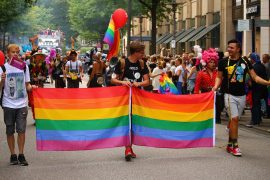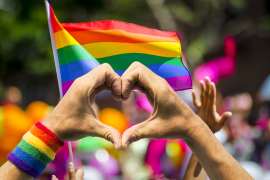Gay is for life, not just for June
“Oh, it’s all right for you guys these days, isn’t it? ‘Gay’ just isn’t an issue any more,” said a well-meaning senior executive the week after Pride Month. With a smile they continued to describe their fleeting encounter with a local Pride parade, seeing it as a sure sign that the race to equality was a done deal.

LGBTQ+ people’s visibility in a world that’s decidedly less ‘rainbowy’ the rest of the year.
Sure, the rainbow explosion across the world this June sent an incredibly positive message – we see your community and we stand with you. Across June, most offices I walked through were awash with Pride colours, giving many LGBTQ+ people visibility in a world that’s decidedly less ‘rainbowy’ the rest of the year.
But wait a second, what about the rest of the year? As the world does a deep rainbow cleanse and organisations lower their Pride flags, I wonder, is this it? Are things sorted for another year? Does this tell us that ‘gay’ (and lesbian, bisexual, transgender, queer… ) really isn’t an issue any more?
Despite the advertising, the logos and the Pride float being ticked off the list, many fintech organisations simply aren’t doing enough to prevent their LGBTQ+ employees facing fundamental barriers to success and respectful treatment.
For organisations ‘mature’ in this conversation, perhaps not. For many others, Pride Month is the exception to the rule. Being LGBTQ+ for June but probably not for life. With that in mind, what are LGBTQ+ inclusivity efforts really achieving and what more should financial services organisations be doing?
Hitting the wall of complacency
Before we go any further, it is probably worth reflecting on what I call ‘the state of gay’ today – where exactly are we on our road towards blind acceptance of the LGBTQ+ community?
It would seem that we’ve taken our foot off the gas and taken a pit-stop. The latest results from the British Social Attitudes survey found that acceptance of same-sex relationships in the UK has stalled, with no significant increase in support recorded since 2016; the first such incidence since 1987. It might be that the liberalisation of attitudes towards same-sex relationships is slowing down and perhaps reaching a plateau. While views towards same-sex relationships have positively transformed, there is still a significant minority who feel differently about this issue – something that a lull amongst more progressive attitudes may be allowing to rise across society and our organisations.
The lived experience of LGBTQ+ people at work is often one of acceptance, respect and inclusion. That said, the impact of these more negative findings has already been seen in many of our organisations today. According to lobbying group Stonewall, a number of LGBTQ+ employees still experience discrimination, abuse and harassment in today’s workplace. Findings from its 2019 Work Report make for some uncomfortable reading:
- one in five LGBT staff have been the target of negative comments or conduct from work colleagues because they’re LGBT
- one in eight trans people have been physically attacked by customers or colleagues because of being trans
- one-third of LGBT staff have hidden or disguised that they are LGBTQ+ at work to avoid discrimination

Stonewall featured only six banks and two tech companies.
Stonewall isn’t alone in its findings. In 2018, Deloitte asked more than 3,000 of its clients’ people if they had ever ‘covered’ themselves at work – when individuals go to great lengths to hide characteristics. Of the LGBTQ+ people who were asked, 85% said they had covered a part of themselves at work – hiding or disguising their sexuality or gender identity due to fears of discrimination or receiving negative reactions from their colleagues. Stonewell’s findings suggest that there is good reason for this as one in five LGBT employees still experience negative comments or behavior from colleagues due to their sexuality – derogatory remarks, being outed without consent or being bullied at work.
Not only must this level of self-regulation be utterly exhausting but it points to working environments that essentially aren’t ‘safe’ for LGBTQ+ employees – safe to be themselves, safe to be authentic and safe to do a great job without constant self-management – something that robs many of the chance to simply do a great job. What’s telling is that these findings come from organisations that ‘burst with Pride’ throughout June.
Despite the advertising, the logos and the Pride float being ticked off the list, many organisations and fintech firms simply aren’t doing enough to prevent their LGBTQ+ employees facing fundamental barriers to success and respectful treatment. Across its Top 100 Employers 2019 list, Stonewall featured only six banks and two tech companies – Fujitsu (34) and Thoughtworks (91). It would seem the sector has a mountain to climb to make inclusion of its LGBTQ+ employees a top priority.
It has to be asked, is the tick-box approach just not working any more?
We’re still ticking boxes
Many of us will be familiar with the common ‘end goals’ for an organisation’s inclusivity efforts. Whether it be a keenness to see an increase in customer satisfaction (a 2012 Gallup study saw inclusive organisations achieving a 39% increase in customer satisfaction scores) or better employee engagement (In 2015, Deloitte found organisations committed to inclusion see 47% higher engagement). Of course, these results can only be realised when we capitalise on the talent and potential of the entire workforce, not just those who are like us or seen to be a ‘safe pair of hands’. The reality is that your top performer, the one with that critical product idea or efficiency methodology, in the future, is likely to be different from the norm and could be the LGBTQ+ individual managing themselves.
Is the tick-box approach just not working any more?
Talent can look differently from our expectations and it’s crucial that organisations grow inclusive cultures that get the biggest return on investment (ROI) on that talent. Workplaces inclusive of LGBTQ+ employees are essential for employers who wish to retain high-performing staff but also attract top talent. An overt commitment to LGBTQ+ employees does show a positive intent to support them and other marginalised groups, but it may not ensure their success and ability to contribute to the wider performance of the organisation unless the right environment is created year round. Simply, when an environment is created where anyone is able to be themselves, we see performance that is sustained and individuals who thrive.
There are so many established ways to grow this kind of culture, many of which are currently being adopted by a number of engaged organisations – or, which is probably more of a truism, well-intentioned groups or individuals trying to make something happen. Below are some examples of common approaches to LGBTQ+ inclusion that I have seen that start to move the needle forward:
- Review and develop clear policies: Companies are now developing zero tolerance policies on homophobic, biphobic and transphobic discrimination and workplace harassment. These principles set the foundation for standards throughout a company, being explicit on what is and is not acceptable. Moreover, specialised benefits are also being extended to LGBTQ+ employees, such as appropriate healthcare coverage and equivalent spousal benefits such as relocation assistance and adoption/surrogacy support. Like any set of policies, they live and die on active and effective communication to all staff and ensuring they’re brought to life with consistent, authentic and willing support from leadership, moving beyond headline statements.
- Provide training: Training is used as an effective way of educating everyone on LGBTQ+ issues and identities (for example, competing identities, the differences in gender expression and dual discrimination) and the policies that have been devised. Critically, anyone attending should leave being accountable for their own behaviour and confidently taking a zero-tolerance approach to discrimination. This is dependent on individuals feeling able to do so within the realities of day-to-day work – something that needs to be driven through support from the top, consistent messaging, practical tools, questioning bias, testing objectivity and real-world opportunities to actually do it. Training will fail without a supportive ecosystem wrapped around it, promoting what is learned.
- Set up a network: Creating a safe space for LGBTQ+ colleagues to meet up and share opportunities and challenges in their day-to-day working life, improving upon issues that directly affect those within the community.
- Appoint LGBTQ+ allies: A network of non-LGBTQ+ people passionate about and interested in the rights of the community can be a crucial source and loud voice of support. Key to success of an allies initiative is that it is active, where problematic behaviour is consistently questioned and individuals keep abreast of issues important to the community they’re supporting. For me, an ally is a verb, a doing word.
- Champion visible role models: Senior leaders need to be at the helm of any effort to promote and support LGBTQ+ inclusion, setting the tone from the top. To do this, organisations need to empower their leaders to make visible commitments to LGBTQ+ equality – by speaking at events, writing internal communications and sponsoring both an allies programme and the LGBTQ+ network. Where this fails is when leaders approach this glibly and with little belief, where empty words are said. Authenticity plays a huge role here, where actions are believed and statements are seen as more than just lip service.
Many of these efforts, whilst obviously great, can move at a glacial pace. I have seen many initiatives, left to grow organically, through willing volunteers who promote programmes, network events, etc. Many such enterprises successfully ‘engage the engaged’ but rarely seem to penetrate audiences that truly need to be part of this work. Whilst I don’t intend to enter the mandatory vs. voluntary debate around inclusion issues in this article, there is much to be said for organisation-wide practices, led with conviction by every level of leadership, that consistently embed inclusive behaviour.
That said, it would be remiss of me not to acknowledge the hard work and lengths to which organisations go to in order to create environments that accept and include LGBTQ+ people. Doing something is also far more preferable than doing nothing at all – it shows that there is commitment and there is foresight from pockets within the organisation, all vital ingredients to creating that LGBTQ+ inclusive environment. There are many talented people on the front line striving to make a difference and their work should be applauded. But can it really be claimed that they are achieving the impact that we all hope for? We only have to point to the troubling findings outlined above to know that current efforts are missing the mark for a significant number of our LGBTQ+ colleagues. Is now the time to admit that rainbows aren’t enough, to take a hard-line stance on individuals and their day-to-day actions? Is it time to engage the disengaged?
When rainbows aren’t enough
“You can put as many rainbows as you like on your apps, your store fronts, logos and websites… but if I can’t walk down the street without the threat of being abused, it doesn’t really matter.”
Tabatha Benjamin, musician and LGBTQ+ activist
The sad reality is that, for a number of LGBTQ+ people in organisations today, the current efforts just aren’t making the difference needed. Sometimes, organisations are awarded for the presence of initiatives and policies that still run flat among the very people they’re designed to support (due to continuing to encounter uncomfortable scenarios and behaviour) whilst going entirely unnoticed by those who need to adhere to them the most. Essentially, they can be shoehorned into cultures that aren’t ready to lean into the issue as routine, resulting in inconsistent behaviour at best and outright discrimination at worst.
Organisations need to better understand and, more importantly, measure what it really means to be accepted, included and valued as an LGBTQ+ employee. Essentially, what is seen to be most valued by a number of marginalised groups within an organisation is a reduction in feeling ‘othered’ or outside of the traditional power structures and instead feeling ‘safe’ to be who they are, take risks regardless of status, speak out when they have a strong opinion and feel able to be their authentic selves without fear of negative consequences to their career or working relationships.

the current efforts just aren’t making the difference needed.
As much as headline initiatives demonstrate good intent and a commitment to change, it’s the water cooler moments, the small comments, the feeling of acceptance and the behaviours witnessed that are the real game changers for individuals. The reality is that, in order cultivate real inclusion for LGBTQ+ people, organisations need to stamp out the behaviours that tell them they are not OK; this means undoing years of systemic and institutionalised norms through clear and uncompromising behavioural standards. From leaders to the newest of graduates, not only should everyone be aware of these standards but they should be prepared to stand by them, be measured against them and have it as a key marker of performance – yes, inclusive behaviour needs to be a core KPI across the entire organisation. This approach demonstrates real commitment to inclusion, requiring all employees to take responsibility and bring to life what would otherwise remain words on a page. To foster a sense a safety amongst LGBTQ+ employees, they need to feel confident that inclusive behaviours are prioritised, felt and seen every day.
Microsoft is one of a few prominent organisations that have made inclusion every employee’s responsibility, tying components of executive compensation to inclusion goals and incorporating inclusion into its performance review process for every employee. This approach cuts right into the heart of what it means to behave and perform within the organisation, keeping everyone accountable – even those who would not naturally show up for Pride or an allies network – and ensures that everyone has a stake in evolving the culture.
To get started on this, do the following to put behaviour at the heart of your efforts to include the LGBTQ+ community:
- Build an inclusive behavioural framework: A well-defined and tiered behavioural framework that is applicable to all levels of the organisation explicitly outlines what inclusion actually looks like, what it is in practice and what individuals should be doing to demonstrate it. Working in the same way as a competency framework, the behaviours can also be benchmarked – reflecting the extent of behaviour needed at each level and what good looks like.
- Consistent measurement: Measuring behaviour needs to be done at regular intervals to track progress, highlight where strengths are emerging and identify where potential gaps may lie. Not only will this inform personal development and the design of specific interventions, the measures can feed into the wider performance management of all employees, positioning inclusion as a core tenet of performance and success.
- Remaining accountable: A behavioural approach puts the responsibility for inclusion into the hands of every individual in the organisation. Explicit examples and behavioural indicators demonstrate the desired standard whilst measurement keeps individuals committed to developing and displaying the right behaviours.
#DontLetTheRainbowsFade

#DontLetTheRainbowsFade
We are all striving to create a workplace that systemises the inclusion of all employees from across society, where everyone can realise their potential. Core to this effort is continuing efforts that maintain awareness of minority groups and provide visibility of their needs and identities – something that Pride does so well for the LGBTQ+ community for one rainbow-clad moment. However, more radical steps are sorely needed to
fundamentally transform the lived experiences of this community in our organisations.
One incidence of harassment, bullying or enforced covering is one too many in our modern workplaces. This is constant work that requires maintenance, engagement and energy throughout the entire year and from everybody, not just an engaged and vocal minority.
Yes, ‘gay’ may not be as big an issue any more. But it’s certainly one that still hangs in the balance – especially when the rainbows of June fade away.
by Alasdair James Scott, a senior consultant at worldwide diversity and inclusion training consultancy PDT Global.











































Excellent piece. Full of frank advice for how to really change things.
Thanks Alasdair Scott – your work at PDT Global is changing how people see this work and making them far more capable of doing something practical.